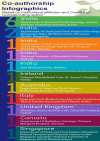Research Landscape of Lymphovascular Invasion in Oral Squamous Cell Carcinoma: A Bibliometric Analysis From 1994 to 2023
- PMID: 38021996
- PMCID: PMC10663408
- DOI: 10.7759/cureus.47487
Research Landscape of Lymphovascular Invasion in Oral Squamous Cell Carcinoma: A Bibliometric Analysis From 1994 to 2023
Abstract
The primary factor affecting tumor biology is neo-lymphangiogenesis in solid epithelial malignancies like oral squamous cell carcinoma (OSCC). Determining the impact of lymphovascular invasion is critical in order to determine OSCC's locoregional and global dissemination. Bibliometric landscapes are vital to learning about the most recent advancements in the aforementioned topic because the ongoing research in OSCC is multifaceted. This analysis can reveal the progressions that might modernize OSCC diagnosis and treatment. The present analysis has been therefore undertaken to study the relevance and effects of lymphovascular invasion in OSCC utilizing co-occurrence of keywords analysis and co-authorship analysis in the PubMed database. The keywords included "lymphovascular invasion in oral squamous cell carcinoma" using the Boolean operator (AND). A cross-sectional bibliometric analysis of full-text articles from 1994 to 2023 using VOSviewer (Version 1.6.19; Centre for Science and Technology Studies, Leiden University, The Netherlands) was performed. The data obtained was analyzed for co-occurrence and co-authorship analysis using the VOSviewer standard protocol. The query revealed 296 searches in the PubMed database. Seven clusters were found with default colors in the representation of the entire term co-occurrence network, which also displayed a total link strength of 22,262. The items were categorized into clusters based on their commonalities. The labels' weights, as determined by links and occurrences, did not depend on one another, and the co-occurrence of keywords does not imply a causal association. In the item density visualization, item labels represented individual things. The number of items from a cluster that was close to the point was represented by the weight given to its color, which was formed by combining the colors of other clusters. A network of 57 authors who matched the search parameters was discovered by the co-authorship analysis. The network visualization map displayed three clusters with a total link strength of 184. The quantity of co-authorship relationships and the number of publications did not appear to be significantly correlated. In conclusion, this investigation uncovered a sizable body of bibliometric data that emphasizes key trends and advancements in the aforementioned theme. The observed variances may be a result of the various objectives of the researchers and journals, who collaborate to provide the best possible literature dissemination.
Keywords: bibliometric analysis; cluster; item; lymphovascular invasion; network visualization; oral squamous cell carcinoma.
Copyright © 2023, Tandon et al.
Conflict of interest statement
The authors have declared that no competing interests exist.
Figures












References
-
- Oral cancer - the fight must go on against all odds…. Evid Based Dent. 2022;23:4–5. - PubMed
-
- Head and neck squamous cell carcinoma. Johnson DE, Burtness B, Leemans CR, Lui VW, Bauman JE, Grandis JR. https://www.nature.com/articles/s41572-020-00224-3. Nat Rev Dis Primers. 2020;6:92. - PMC - PubMed
-
- Cancer statistics, 2023. Siegel RL, Miller KD, Wagle NS, Jemal A. CA Cancer J Clin. 2023;73:17–48. - PubMed
Publication types
LinkOut - more resources
Full Text Sources
